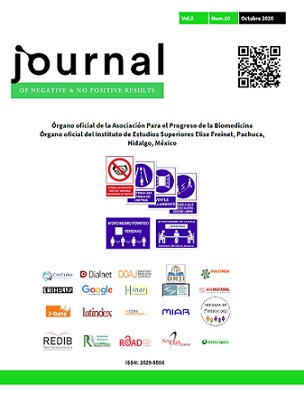Perception of the educational environment in pre-degree internal doctors of the faculty of medicine and surgery, URSE
DOI:
https://doi.org/10.19230/jonnpr.3626Keywords:
Educational environment, Oaxaca, DREEM, URSEAbstract
Introduction. The educational environment refers to tangible and intangible conditions in an institution and is associated with student satisfaction.
Objective. To determine the perception of the educational environment that internal undergraduate doctors of the Faculty of Medicine and Surgery (URSE) have during the 2018-2019 school year.
Materials and methods. Descriptive-cross-sectional study, the Postgraduate Hospital Education Environment (PHEEM) questionnaire was used to undergraduate internal physicians, the data analysis was performed through descriptive statistics using SPSSâ and the database was prepared through Excel
Results. The questionnaire was answered by 124 internal doctors (women: 44%, men: 56%; age: 24.71 years), the overall PHEEM score was classified as an excellent educational environment.
Conclusions. The educational environment is perceived as excellent, the development of medical-surgical practices and diagnosis in the various boarding school services must still be improved, as a negative aspect, the poor rotation by the Family Medicine service is observed.
Downloads
References
Manual del Interno. Universidad Michoacana de San Nicolás de Hidalgo: UMSNH; 2003-2004.
Tapia Villanueva RM, Núñez Tapia RM, Salas Perea RS, Rodríguez Orozco AR. El internado médico de pregrado y las destrezas clínicas. México en el contexto latinoamericano. Educ Med Super, 2007; 21(4): 1-10.
Ley General de Salud, México. 2018.
Sánchez Flores A, Flores Echavarría R, Urbina Becerra R, Lara Flores NL. Expectativas y realidades del internado médico de pregrado. Un estudio cualitativo. Investigación en salud, 2008; X(3): 14-21.
Flores R, Coronado M, Sánchez A. Adhesión profesional médica: una cohorte simulada. Un estudio para su medición. Investigación en salud, 2001; 3(1): 13-19. Roff, Sue, McAleer, Sean, Harden, Ronald M., Al-Qahtani, Mona, Ahmed, Ashraf Uddin, Deza, Haracio, Groenen, Guido, Primparyon P. Development and validation of the Dundee Ready Education Environment Measure (DREEM). Med Teach, 1997; 19(4): 295.
Roff S, McAleer S, Skinner a. Development and validation of an instrument to measure the postgraduate clinical learning and teaching educational environment for hospitalbased junior doctors in the UK. Med Teach, 2005; 27(4): 326-31.
Clapham M, Wall D, Batchelor A. Educational environment in intensive care medicineuse of Postgraduate Hospital Educational Environment Measure (PHEEM). Med Teach, 2007; 29(6): e184-91.
Herrera CA, Olivos T, Román JA, Larraín A, Pizarro M, Solís N, et al. Evaluation of the educational environment in medical specialty programs | Evaluación del ambiente educacional en programas de especialización médica. Rev Med Chil, 2012; 140(12): 1554-61.
Mohammad Jalili MD, Mina Ghalandari MD, Maziar Moradi-Lakeh MD A, Mirzazadeh MD SRM. Validating Modified PHEEM Questionnaire for Measuring Educational Environment in Academic Emergency Departments. Arch Iran Med, 2014; 17(5): 372-7.
Koutsogiannou P, Dimoliatis IDK, Mavridis D, Bellos S, Karathanos V, Jelastopulu E. Validation of the Postgraduate Hospital Educational Environment Measure (PHEEM) in a sample of 731 Greek residents. BMC Res Notes, 2015; 8(1): 734.
Palmgren PJ, Lindquist I, Sundberg T, Nilsson GH, Laksov KB. Exploring perceptions of the educational environment among undergraduate physiotherapy students. Int J Med Educ, 2014; 5: 135-46.
Arce Antezana O, Larrazábal Córdova C, Antezana Soria Galvarro M. Aplicación del instrumento de encuesta PHEEM de Roff et al. en residentes de especialidad médica en la Facultad de Medicina de la Universidad Mayor de San Simón. Gac Med Bol, 2015; 38(2): 47-51.
Medina ML, Medina MG, Gauna NT, Molfino L, Merino LA. Evaluación del ambiente educacional en la residencia de Clínica Pediátrica en un Hospital de Referencia Provincial. Educación Médica, 2020; 21(1): 24-31.
Concepción-Gómez RA, Asprilla-González JA. Aplicación del cuestionario PHEEM a médicos internos en 5 hospitales de Panamá. Inv Ed Med, 2017. http://dx.doi.org/10.1016/j.riem.2017.04.007
Published
Issue
Section
License
All accepted originals remain the property of JONNPR. In the event of publication, the authors exclusively transfer their rights of reproduction, distribution, translation and public communication (by any sound, audiovisual or electronic medium or format) of their work. To do so, the authors shall sign a letter transferring these rights when sending the paper via the online manuscript management system.
The articles published in the journal are freely used under the terms of the Creative Commons BY NC SA license, therefore.
You are free to:
Share — copy and redistribute the material in any medium or format
Adapt — remix, transform, and build upon the material
The licensor cannot revoke these freedoms as long as you follow the license terms.
Under the following terms:
Attribution — You must give appropriate credit, provide a link to the license, and indicate if changes were made. You may do so in any reasonable manner, but not in any way that suggests the licensor endorses you or your use.
NonCommercial — You may not use the material for commercial purposes.
ShareAlike — If you remix, transform, or build upon the material, you must distribute your contributions under the same license as the original.
No additional restrictions — You may not apply legal terms or technological measures that legally restrict others from doing anything the license permits.

This work is licensed under a Creative Commons Attribution-NonCommercial-ShareAlike 4.0 International License

























